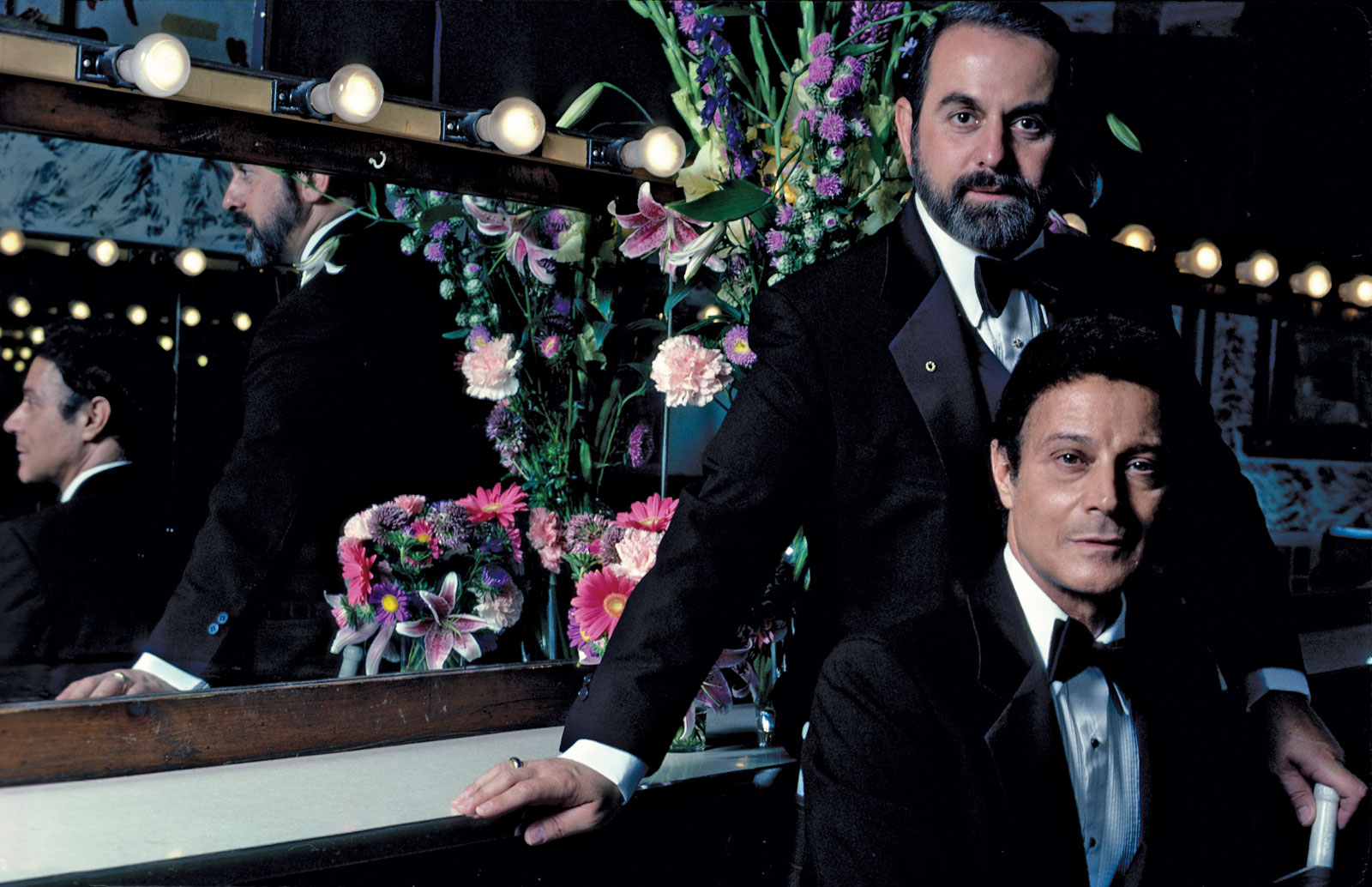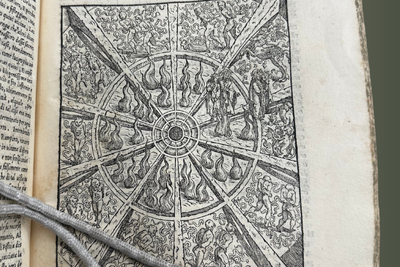This spring, as Seattle and the world comes to a halt in the battle against the coronavirus, every act of kindness, every moment of beauty, becomes more important than ever. Art museums may be shuttered, concerts may be postponed and theater performances delayed, but communities are coming together in new and creative ways to share comfort and joy.
Music has always been a way to lighten the spirit, and Seattle has been the home of many gifted artists. One of these Seattle natives was Robert Joffrey, founder of the Joffrey Ballet. A dancer, teacher, choreographer and artistic director, Joffrey is known for bringing a distinctly American approach to dance.
Robert Joffrey was born around 1930; the exact year is unknown. His father was Afghani and his mother was Italian, and at his birth he was given the name of Abdullah Jaffa Bey Khan. His family owned a group of restaurants in Seattle, including one on Boren Street called the Italian Tavern. His mother, Maria, was born in Lucca where she trained as a concert violinist and a nurse. As the only child of immigrants, Robert grew up believing that, with sacrifice and hard work, the American dream was within his grasp.
As a child, Joffrey was small and sickly. Even fully grown, he was only 5’4”. His feet turned in and he had to wear heavy casts as a youngster. He had a host of respiratory allergies which triggered asthma attacks. His parents enrolled him in dance classes to help (luckily, there was a dance school right above the family restaurant). He loved everything about dance. Some evenings, he would perform in the restaurant for the customers, saving the tips he got to pay for more books about dance.
When he was 10, he was cast as an extra in a production of Petrouchka, earning a 50-cent paycheck. For anyone else, it might have been just a lark, but for Joffrey the drama and thrill of performing spoke to his soul. He decided that someday he would start his own ballet company. By the time he reached his mid-teens, he was done with high school and with Seattle. All he wanted to do was move to New York and start his career as a professional dancer.
His life changed when he met Gerald (Gennaro) Arpino. The youngest of nine children born into an Italian family, Arpino grew up on Staten Island and enlisted in the Coast Guard during World War II. His military service took him to Seattle where his mother asked him to get in touch with her old friend Maria Joffrey. Thanks to that connection, the two young men met. Joffrey later admitted it was love at first sight. Arpino moved to Seattle in 1946, took up residence with the Joffrey family, and began to study dance.
Both men studied under Mary Ann Wells, a gifted teacher who influenced many Northwest dancers. As a final graduation project, she asked Joffrey to produce a full evening of dance. He had to choose his own music, create the choreography, design the costumes and sets, rent the theater space and advertise the event. It was a huge success and earned him his first published review.
The pair decided to move east and this time, they settled in with the Arpino family on Staten Island. In New York, Joffrey danced, choreographed and taught ballet, including a stint at Manhattan’s High School of Performing Arts. He opened his own ballet school in 1953, but then disaster struck. While performing at the American Dance Festival, he tore a ligament in his calf and had to crawl off the stage. His dance career was over. It was time to establish his own company.
Both men were ambitious and envisioned a company unlike any other. They wanted to use young, strong, athletic dancers who would perform an eclectic repertory that freely mixed ballet with modern dance. The Robert Joffrey Theatre Ballet was founded in 1954 and for the next several years, Joffrey traveled between Seattle, New York and London. He taught at Seattle’s Cornish School and choreographed performances for the Aqua Theatre at Green Lake, including productions of Carousel and Oklahoma.
As with most arts organizations, money was always tight and the Joffrey Ballet see-sawed between stellar accolades and near-bankruptcy. In 1956, six Joffrey dancers in a borrowed station wagon pulling a U-Haul filled with sets and costumes traveled from town to town, performing in high school gyms and community centers. When the World’s Fair opened in 1962 in Seattle, Joffrey’s choreography of Aida inaugurated the new Seattle Opera House. In 1966, the troupe appeared on the Ed Sullivan Show.
Despite problems, Joffrey remained upbeat. “For the choreographer,” he said, “the last part of the 20th century is a wonderful and exciting age to live in. Great possibilities lie ahead.” His productions were known for their experimental techniques and expansive cinematic lighting.
The struggle for funding continued. At one point, Joffrey and Arpino lived in a storage room at the back of their school in New York, without a kitchen, bathroom or heat on the weekends. In 1979, Joffrey laid off more than 30 dancers, which effectively canceled his season in New York and a European tour. Although a federal arts grant bought him a few months’ reprieve, the loss of so many veteran dancers was a serious set-back.
In the mid-1980s, Joffrey contracted AIDS and died on March 25, 1988, at the age of 57. Arpino succeeded him as artistic director. He moved the Joffrey Ballet to Chicago in 1995 where it continues to bring a unique and inclusive perspective to dance. Arpino died in Chicago in 2008 at the age of 85.
Questa primavera, mentre Seattle e il mondo si fermano nella battaglia contro il coronavirus, ogni atto di gentilezza, ogni momento di bellezza diventa più importante che mai. I musei d’arte possono essere chiusi, i concerti possono essere rinviati e gli spettacoli teatrali posticipati, ma le comunità si riuniscono in modi nuovi e creativi per condividere conforto e gioia.
La musica è sempre stata un modo per alleggerire lo spirito, e Seattle è stata la patria di molti artisti di talento. Uno di questi abitanti di Seattle è stato Robert Joffrey, fondatore del Joffrey Ballet. Ballerino, insegnante, coreografo e direttore artistico, Joffrey è noto per aver portato un approccio decisamente americano alla danza.
Robert Joffrey è nato intorno al 1930; l’anno esatto è sconosciuto. Suo padre era afgano e sua madre era italiana, e alla sua nascita gli fu dato il nome di Abdullah Jaffa Bey Khan. La sua famiglia possedeva un gruppo di ristoranti a Seattle, tra cui uno in Boren Street chiamato Italian Tavern. Sua madre, Maria, era nata a Lucca dove si è formata come violinista da concerto e infermiera. Unico figlio di immigrati, Robert è cresciuto credendo che, con il sacrificio e il duro lavoro, il sogno americano fosse alla sua portata.
Da bambino, Joffrey era piccolo e malaticcio. Anche una volta cresciuto, era alto solo un metro e settanta. I suoi piedi si rivoltarono e da giovane dovette indossare dei pesanti plantari. Aveva una serie di allergie respiratorie che scatenavano attacchi d’asma. I suoi genitori lo iscrissero a corsi di ballo per aiutarlo (per fortuna c’era una scuola di ballo proprio sopra il ristorante di famiglia). Amava tutto ciò che riguardava la danza. Alcune sere si esibiva nel ristorante per i clienti, risparmiando le mance per pagare altri libri sulla danza.
A 10 anni venne stato scritturato come comparsa in una produzione di Petrouchka, guadagnando uno stipendio di 50 centesimi. Per chiunque altro, poteva essere nulla, ma per Joffrey il dramma e l’emozione di esibirsi parlavano alla sua anima. Decise che un giorno avrebbe fondato una sua compagnia di danza. Quando raggiunse l’adolescenza, aveva già chiuso con il liceo e Seattle. Tutto ciò che voleva fare era trasferirsi a New York e iniziare la sua carriera di ballerino professionista.
La sua vita cambiò quando incontrò Gerald (Gennaro) Arpino. Il più giovane di nove figli, nato in una famiglia italiana, Arpino era cresciuto a Staten Island e si era arruolato nella Guardia Costiera durante la Seconda Guerra Mondiale. Il servizio militare lo portò a Seattle dove la madre gli chiese di mettersi in contatto con la sua vecchia amica Maria Joffrey. Grazie a questo legame, i due giovani si incontrarono. Joffrey ammise più tardi che fu amore a prima vista. Arpino si trasferì a Seattle nel 1946, si stabilì con la famiglia Joffrey e iniziò a studiare danza.
Entrambi studiarono sotto la guida di Mary Ann Wells, un’insegnante di talento che ha influenzato molti ballerini del Nord-Ovest. Come progetto di diploma finale, lei chiese a Joffrey di produrre una serata di ballo completa. Doveva scegliere la musica, creare la coreografia, disegnare i costumi e le scenografie, affittare lo spazio del teatro e pubblicizzare l’evento. Fu un enorme successo e gli valse la sua prima recensione pubblicata.
La coppia decise di trasferirsi a Est e questa volta si stabilì con la famiglia Arpino a Staten Island. A New York, Joffrey ha ballato, coreografato e insegnato danza classica, incluso un periodo alla High School of Performing Arts di Manhattan. Ha aperto la sua scuola di danza nel 1953, ma poi è stato un disastro. Mentre si esibiva all’American Dance Festival, si strappò un legamento del polpaccio e dovette strisciare giù dal palco. La sua carriera di ballerino era finita. Era giunto il momento di fondare una sua compagnia.
Entrambi gli uomini erano ambiziosi e immaginavano una compagnia diversa da tutte le altre. Volevano utilizzare ballerini giovani, forti e atletici che si esibissero in un repertorio eclettico che mescolasse liberamente il balletto con la danza moderna. Il Robert Joffrey Theatre Ballet fu fondato nel 1954 e per gli anni successivi, Joffrey viaggiò tra Seattle, New York e Londra. Ha insegnato alla Cornish School di Seattle e coreografato spettacoli per l’Aqua Theatre at Green Lake, comprese le produzioni di Carousel e Oklahoma.
Come per la maggior parte delle organizzazioni artistiche, i soldi sono sempre stati pochi e il Joffrey Ballet è sempre stato in bilico tra riconoscimenti stellari e la quasi bancarotta. Nel 1956, sei ballerini della Joffrey in una station wagon presa in prestito che trainava una U-Haul piena di set e costumi viaggiavano di città in città, esibendosi nelle palestre delle scuole superiori e nei centri comunitari. Quando l’Esposizione Universale di Seattle aprì nel 1962, la coreografia di Joffrey dell’Aida inaugurò la nuova Seattle Opera House. Nel 1966, la troupe apparve all’Ed Sullivan Show.
Nonostante i problemi, Joffrey rimase ottimista. “Per il coreografo – ha detto – l’ultima parte del XX secolo è un’epoca meravigliosa ed emozionante in cui vivere. Ci attendono grandi possibilità”. Le sue produzioni erano note per le tecniche sperimentali e per l’ampia illuminazione cinematografica.
La lotta per il finanziamento continuò. A un certo punto, Joffrey e Arpino vissero nel ripostiglio sul retro della loro scuola a New York, senza cucina, bagno o riscaldamento nei fine settimana. Nel 1979, Joffrey licenziò più di 30 ballerini, il che di fatto fece annullare la sua stagione a New York e un tour europeo. Anche se una borsa di studio federale per le arti gli fece guadagnare qualche mese di tregua, la perdita di così tanti ballerini veterani fu una grave battuta d’arresto.
A metà degli anni Ottanta, Joffrey ha contratto l’AIDS ed è morto il 25 marzo 1988, all’età di 57 anni. Arpino gli è succeduto come direttore artistico. Nel 1995 ha trasferito il Joffrey Ballet a Chicago, dove ha continuato a portare una prospettiva unica e inclusiva alla danza. Arpino è morto a Chicago nel 2008 all’età di 85 anni.






























